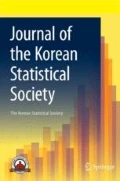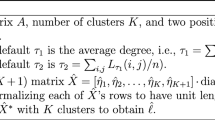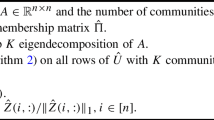Abstract
Mixed membership community detection is a challenging problem. In this paper, to detect mixed memberships, we propose a new method Mixed-SLIM which is a spectral clustering method on the symmetrized Laplacian inverse matrix under the degree-corrected mixed membership model. We provide theoretical bounds for the estimation error on the proposed algorithm and its regularized version under mild conditions. Meanwhile, we provide some extensions of the proposed method to deal with large networks in practice. These Mixed-SLIM methods outperform state-of-art methods in simulations and substantial empirical datasets for both community detection and mixed membership community detection problems.


Similar content being viewed by others
Availability of data and materials
Yes.
Code Availability
Yes.
References
Abbe, E. (2017). Community detection and stochastic block models: recent developments. Journal Machine Learning Research, 18(1), 6446–6531.
Adamic, L. A., Glance, & N. (2005). The political blogosphere and the 2004 us election: Divided they blog. pp. 36–43
Airoldi, E. M., Blei, D. M., Fienberg, S. E., & Xing, E. P. (2008). Mixed membership stochastic blockmodels. Journal Machine Learning Research, 9, 1981–2014.
Amini, A. A., Chen, A., Bickel, P. J., & Levina, E. (2013). Pseudo-likelihood methods for community detection in large sparse networks. Annals Statistics, 41(4), 2097–2122.
Cai, T. T., & Li, X. (2015). Robust and computationally feasible community detection in the presence of arbitrary outlier nodes. Annals Statistics, 43(3), 1027–1059.
Chen, K., & Lei, J. (2018). Network cross-validation for determining the number of communities in network data. Journal American Statistical Association, 113(521), 241–251.
Chen, Y., Li, X., & Xu, J. (2018). Convexified modularity maximization for degree-corrected stochastic block models. Annals Statistics, 46(4), 1573–1602.
Dunne, J. A., Williams, R. J., & Martinez, N. D. (2002). Food-web structure and network theory: the role of connectance and size. Proceedings National Academy Ences United States America, 99(20), 12917.
Fortunato, S. (2010). Community detection in graphs. Physics Reports, 486(3–5), 75–174.
Fortunato, S., & Hric, D. (2016). Community detection in networks: A user guide. Physics Reports, 659, 1–44.
Holland, P. W., Laskey, K. B., & Leinhardt, S. (1983). Stochastic blockmodels: First steps. Social Networks, 5(2), 109–137.
Jin, J. (2015). Fast community detection by SCORE. Annals Statistics, 43(1), 57–89.
Jing, B., Li, T., Ying, N., & Yu, X. (2022). Community detection in sparse networks using the symmetrized laplacian inverse matrix (slim). Statistica Sinica, 32(1), 1.
Jin, J., Ke, ZT., & Luo, S. (2017). Estimating network memberships by simplex vertex hunting. arXiv preprint arXiv:1708.07852
Joseph, A., & Yu, B. (2016). Impact of regularization on spectral clustering. Annals Statistics, 44(4), 1765–1791.
Karrer, B., & Newman, M. E. J. (2011). Stochastic blockmodels and community structure in networks. Physical Review E, 83(1), 16107.
Leskovec, J., & Mcauley, J. J. (2012). Learning to discover social circles in ego networks. Advances Neural Information Processing Systems, 25, 539–547.
Lusseau, D. (2003). The emergent properties of a dolphin social network. Proceedings of the Royal Society of London Series B: Biological Sciences 270(2):186–188
Lusseau, D. (2007). Evidence for social role in a dolphin social network. Evolutionary Ecology, 21(3), 357–366.
Lusseau, D., Schneider, K., Boisseau, O. J., Haase, P., Slooten, E., & Dawson, S. M. (2003). The bottlenose dolphin community of Doubtful Sound features a large proportion of long-lasting associations. Behavioral Ecology Sociobiology, 54(4), 396–405.
Mao, X., Sarkar, P., & Chakrabarti D. (2017). On mixed memberships and symmetric nonnegative matrix factorizations. International Conference on Machine Learning. 2324–2333
Mao, X., Sarkar, P., & Chakrabarti, D. (2020). Estimating mixed memberships with sharp eigenvector deviations. Journal American Statistical Association., 116(536), 1–13.
Ma, S., Su, L., & Zhang, Y. (2021). Determining the number of communities in degree-corrected stochastic block models. Journal Machine Learning Research., 22(69), 63.
Nepusz, T., Petróczi, A., Négyessy, L., & Bazsó, F. (2008). Fuzzy communities and the concept of bridgeness in complex networks. Physical Review E, 77(1), 016107.
Newman, M. E. J. (2004). Coauthorship networks and patterns of scientific collaboration. Proceedings National Academy Sciences, 101(suppl 1), 5200–5205.
Newman, M. E., & Girvan, M. (2004). Finding and evaluating community structure in networks. Physical Review E, 69(2), 026113.
Pizzuti, C. (2008). Ga-net: a genetic algorithm for community detection in social networks. In: International Conference on Parallel Problem Solving from Nature, pp. 1081–1090. Springer
Qin, T., & Rohe, K. (2013). Regularized spectral clustering under the degree-corrected stochastic blockmodel. Advances Neural Information Processing Systems, 26, 3120–3128.
Rohe, K., Qin, T., & Yu, B. (2016). Co-clustering directed graphs to discover asymmetries and directional communities. Proceedings National Academy Sciences, 113(45), 12679–12684.
Scott, J., & Carrington, P. J. (2011). The sage handbook of social network analysis. London: SAGE Publications.
Su, L., Wang, W., & Zhang, Y. (2019). Strong consistency of spectral clustering for stochastic block models. IEEE Transactions Information Theory, 66(1), 324–338.
Zhang, Y., Levina, E., & Zhu, J. (2020). Detecting overlapping communities in networks using spectral methods. SIAM Journal Mathematics Data Science, 2(2), 265–283.
Zhao, Y., Levina, E., & Zhu, J. (2012). Consistency of community detection in networks under degree-corrected stochastic block models. Annals Statistics, 40(4), 2266–2292.
Funding
Qing’s work was supported by High level personal project of Jiangsu Province (JSSCBS20211218). Wang’s work was supported by the Fundamental Research Funds for the Central Universities, Nankai University, 63221044 and the National Natural Science Foundation of China (Grant 12001295).
Author information
Authors and Affiliations
Contributions
Authors’ contributions. Qing mainly worked on the algorithm and theoretical properties. Wang mainly worked on the algorithm and whole paper organization.
Corresponding author
Ethics declarations
Conflict of interest
(check journal-specific guidelines for which heading to use) None.
Ethics approval
None.
Consent to participate
Yes.
Consent for publication
Yes.
Additional information
Publisher's Note
Springer Nature remains neutral with regard to jurisdictional claims in published maps and institutional affiliations.
Supplementary Information
Below is the link to the electronic supplementary material.
Supplementary information
The proofs of lemmas and theorem are provided in the Supplementary. (pdf 251KB)
Rights and permissions
Springer Nature or its licensor (e.g. a society or other partner) holds exclusive rights to this article under a publishing agreement with the author(s) or other rightsholder(s); author self-archiving of the accepted manuscript version of this article is solely governed by the terms of such publishing agreement and applicable law.
About this article
Cite this article
Qing, H., Wang, J. Estimating mixed-memberships using the symmetric laplacian inverse matrix. J. Korean Stat. Soc. 52, 248–264 (2023). https://doi.org/10.1007/s42952-022-00199-9
Received:
Accepted:
Published:
Issue Date:
DOI: https://doi.org/10.1007/s42952-022-00199-9




